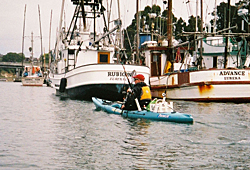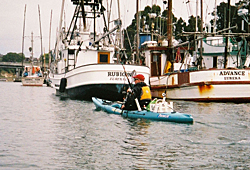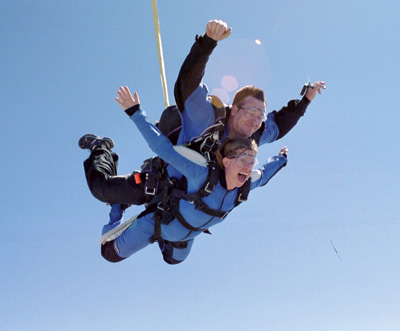- Tahoe’s Nevada Beach Tops the List of Hard-to-Book Campgrounds - 07/17/2024
- Cannabis Watershed Protection Program Cleans Up Illegal Grow Sites - 07/10/2024
- French Fire - 07/05/2024
By Allen Bushnell

Photo: Pete Gauvin
I’ve been in the ocean all my life, surfing since I was 12 and fishing seriously since age 25. Often I would sit on my board between sets and look longingly at the outside edge of the kelp beds, wishing I had a rod with me to catch some tasty rockfish for dinner that night. Fishing off my longboard was never very comfortable, so I was completely stoked when my wife bought me our first sit-on-top kayak. I immediately took it out for a full bag of rockfish, and have diligently pursued this exciting sport ever since.
Saltwater kayak fishing has been a popular pursuit in Southern California for a number of years. It’s not unusual to see 40 or 50 kayak anglers out on a summer weekend at La Jolla Cove, for instance. Despite somewhat less hospitable conditions — including bigger seas, colder water, more wind, and a shorter fishing season — paddle-powered fishing is rapidly gaining devotees north of Point Conception. The number of Northern California kayak anglers, once scarcer than a 40-pound halibut, is growing at a consistent rate.
Most saltwater kayak anglers use sit-on-top kayaks, rather than a sit-inside touring boat with a decked cockpit. The SOT offers more usable deck space for equipment and rigging and most include some degree of protected storage via a front or back hatch, or an open rear tankwell. SOT’s may be a bit slower than a sea touring kayak, but they are a lot more stable as a fishing platform and are much easier for performing a self rescue, should you wind up in the water. Made of tough, roto-molded plastic, SOTs offer an inexpensive way to get out on the water. Usually light enough to be handled easily by one person, SOT kayaks can be transported easily on roof racks. They open up many remote areas for fishing without the need for a launch ramp or a lengthy boat ride.
The first concern of the kayak angler, or anyone who ventures even slightly offshore on self-powered craft, is safety. You should know your boat, your abilities, and your limitations. Newbies to the sport are encouraged to take their kayak out to the surf zone, without any equipment aboard, and practice surf entries and recoveries. Fall off the boat deliberately and practice your self-rescue technique. Tip the boat from side to side to test how far on edge it go before capsizing. Learn the secondary stability characteristics of the boat. Practice sitting sideways, backwards, and scooting to the bow and the stern. Test the limits by kneeling and even standing on the boat. Having a physical knowledge of your boat’s limits will go a long way towards staying within those limits when fishing offshore.
There is safety in numbers. When planning a fishing trip, try to get a partner or two for company. Besides being more enjoyable and having witnesses for your big catch, your partners help ensure your safe return. They may also keep you a bit more honest in reporting the size and number of your catch. If no one is available for company, and you have gained enough experience for solo offshore ventures, always let someone know where you will be fishing, and when you expect to return — “file a float plan.” Keep an eye on the weather forecasts and remember conditions can change very quickly in our northern waters. What starts out as a bright calm morning often switches to howling winds and white-capped wind chop, or thick disorienting pea-soup fog.
Every saltwater kayak angler should carry a few items that are considered “the minimum” as safety equipment. Some of these are self evident, but this is by no means a complete list:
PFD (Personal Flotation Device or lifejacket): PFDs are designed to keep a person floating face up when worn correctly. Always wear your PFD properly and you will stay alive even if you are not conscious.
Communication Devices: I prefer a handheld VHF marine band radio. Many models of submersible VHFs are available on the market. This will allow you to speak directly with the Coast Guard, port authorities, or other boaters in your area should you need assistance. Cell phones can serve in a pinch, but should be kept in a dry bag as no submersible models are available. A loud waterproof whistle can come in handy to signal other boaters that you need help, or if it’s foggy, just to let them know you are in the area. Other signaling devices to call for assistance include signal flares, a hand mirror to flash the sun reflection, or a small waterproof air horn.
Paddle Leash: This connects your paddle to your boat or to your PFD. You do not want to have your paddle drift away while you’re a mile offshore fighting a fish. Many kayak anglers will carry an extra paddle inside their boat just in case.

Allen Bushnell fishes for live bait in the harbor.
Photo: Pete Gauvin
Compass: Even the best mariner can get turned around when no landmarks are visible. A compass is a must. Even better are the handheld submersible GPS units that display your exact position using latitude and longitude. Most models include a local marine map upon which you can track progress from your launch point and provide a backtrack feature if necessary. Like anything electronic, GPS units can fail and batteries can die, so always have a compass as your backup.
Proper Clothing: Even at its warmest, our ocean waters will induce hypothermia in a short while. In 50-60 degree water, exhaustion or unconsciousness can occur within an hour and expected survival time is 1 – 6 hours. For this reason, I always wear a wetsuit when paddling out to fish. A farmer-john style suit is probably the best for kayak fishing, as it leaves your arms free for paddling, but will preserve body temperature if you end up in the water. A rash-guard, poly-pro or fleece pullover, windbreaker or paddling jacket are usually plenty for most paddling days in our area. Don’t forget a good hat with a brim for glare, and your UV-blocking sunglasses.
Fishing equipment varies according to each individual angler’s preferences. Most saltwater kayak anglers use conventional gear, that is, open-spool reels and appropriate rods for the species being targeted. A few essentials for rigging your kayak for fishing would include rod holders, a gaff or net and a stringer or bag for holding your fish. Many saltwater anglers adapt 12-volt fishfinder sonar units for their craft. Some consider the fishfinder an essential piece of equipment. Another essential is a drift-chute or sea anchor that an angler can deploy to slow their drift and keep fishing when the winds get strong.
In the Monterey and San Francisco bay areas, and the greater central coast of California, we mostly pursue rockfish and lingcod, halibut, salmon, striped bass or sturgeon. Each of these species requires a different approach in terms of strategy, areas and locales, and often in bait, lures and equipment used. Luckily, practice consists of getting out on the water and actually fishing. No kayak angler will ever forget the heart-stopping moment of his or her first big takedown, or the thrill of a big fish “sleigh ride.”
Even the greenest grommet can find some measure of success to build upon, and near-shore trips for gopher cod and blue rockfish can soon escalate to fishing the edge of the Monterey Bay Canyon where the drop-off plunges thousands of feet and anchovy schools attract big king salmon. Pay attention to your safety equipment and talk to other anglers for tips, tricks and techniques. No one of us knows more than all of us, and anglers, as a rule, are eager to share. (Indeed, sometimes the challenge is to get them to STOP talking!) In Central and Northern California, we’re enjoying the infancy of this sport. The saltwater kayak fishing community is still small and somewhat intimate, much like surfing was in the early 60’s. It’s an eco-friendly, healthful, exhilarating pursuit and to top it off, you get the freshest seafood dinner in town!
Allen Bushnell is the 2003 winner of the Santa Cruz Kayak Fishing Derby. He writes the weekly fishing report for the Santa Cruz Sentinel, and is co-host of “The Let’s Go Fishing Radio Show” that airs every Thursday evening at 7pm on KSCO 1080AM. Bushnell operates a kayak fishing guide service for our area and can be contacted at scruzfishing@yahoo.com, or through these websites:
www.theletsgofishingradioshow.com

Bushnell displays a colorful lingcod before releasing it.
Photo: Pete Gauvin
Morning at Sea
Guided kayak fishing trip introduces writer to growing sport
By Pete Gauvin
We meet at the Santa Cruz Harbor at 5 a.m., painfully early for an unconditioned fisherperson like myself. Seven is early. Five borders on torture. But that apparently is what separates fish catchers from mere line wetters — the willingness to sacrifice a warm bed for a foggy morning of threading bait to your line while sloshing around in the swell.
It had been a couple years since I’d been out on a charter boat, a “party boat,” to drop my line from the rail with 30 to 40 other guys of varying levels of hygiene and beer appreciation. A couple of $70 trips while inhaling engine fumes, pitching and rolling for hours, and getting skunked had pretty much excised my urge to catch my own. Store-bought steaks started to seem like a much better deal.
But here I was, back at the game, only this time I would be my own skipper, and for that matter my own engine. Such is the autonomous nature of kayak fishing.
Down at the launch ramp, real fishermen with manly trucks and serious fishing boats with big motors lined up to launch their pride and joy and kid’s college tuition. Looking on, even a low-impact, wallet-lite sportsman like myself couldn’t subdue irrational pangs of vessel envy. Since boyhood and learning to sail small boats resembling bathtubs, I’d always dreamed of owning a Boston Whaler. It was the pinnacle of my boater-porn fantasies, although I would have settled for anything with an outboard that left a purling wake behind it. My guess is that it stems from watching too many after-school episodes of “Flipper.”
At the bait shop, I meet Allen Bushnell, a college administrator and unofficial kayak fishing ambassador to Northern California. (See accompanying article) He has his own kayak fishing guide service and hosts a radio show on fishing and writes a fishing column for the local paper and magazine articles for “Kayak Fisherman.” Other than that, he’s pretty green.
I plunk down for a fishing license thankful that I don’t have to pass any tests. Allen purchases a couple packages of squid; I think it’s still a bit early for breakfast.
Out front is Allen’s stealth fishing rig: a sporty VW van with a couple sit-on-top kayaks on the roof rack. He says that when the fish are biting up near Davenport he can drive north, launch his kayak and be fishing for a good while before the power boaters even make it to the fishing grounds, swell weary and sea sick.
We hop in and drive over to the kayak-launching dock on the other side of the harbor. We have it to ourselves except for one other kayak fishing denizen — a middle-aged guy bubbling with enthusiasm whom Allen infected with the sport last year. On his first trip with Allen as his guide, the rookie caught a 27-pound halibut, bigger than Allen himself has ever landed. I guess that’ll do it. Of course, he couldn’t help but tell me about it after about 30 seconds. Among fishermen, landing a huge halibut is the equivalent of a frat boy scoring a supermodel — you’re bound to hear about it for years to come.
As the salmon hadn’t started biting and the rockfish and lingcod were still out of season (until July 1), a big fat flat halibut or two would be our piscatorial goal today. One good size halibut would make for a lot of tasty fish tacos, I projected.
After figuring out my fishing outfit — a wetsuit on my lower half and a synthetic shirt, fleece and wind breaker up top — we set off in a matter of minutes, generating a little welcome body heat as we paddled out the harbor, dwarfed by the hulls of commercial fishing vessels and private yachts. Allen stops near the mouth and grabs the smallest of three rods, one fixed with a Sabiki bait rig for catching live bait. He quickly catches a couple frenetic anchovy and tosses them in the battery-powered live bait well behind his seat. I am impressed!
Paddling past the jetty we are met with incoming swell and the adventure begins. We proceed in our roto-molded personal fishing vessels out onto the inky immensity, as power boats of varying stature throttle out for the hunt (weenies!). We paddle out about a mile until Allen’s fishfinder tells us were in just over 50 feet of water. He shows me how to rig the squid to my line with the single hook in the tail end and the treble hook between the eyes. Good thing they’re not cute and fuzzy.
As rays of sunlight begin piercing the fog, we drop our lines to the sea floor and then reel up a turn or two so our bait is just off the bottom, where halibut lurk. As soon as our bait is in position, the bite arrives like knocks at the door. But time after time we reel up and find only colorful, mischievous rockfish on the hook. Apparently they didn’t get the memo that they’re out of season. A little later, Allen pulls up an extravagant turquoise-colored 12-pound lingcod, a tasty fish and a definite keeper, but it too is out of season. What a tease!
Allen mentions another advantage of kayak fishing that hadn’t occurred to me: On a kayak, you can use lighter weight test line with less chance of it being snapped because the kayak acts as natural drag. This is great so long as you don’t hook the sea-going equivalent of Lance Armstrong.
A couple hours into my first kayak fishing adventure, I faced my biggest challenge: I had over hydrated and my bladder alert system was at four alarms. I could no longer chase halibut until taking care of business. But how from a kayak in rolling swell? Thankfully I was on an ultra-stable model that allowed me to kneel. But it was a shaky operation that I wouldn’t recommend unless you’re a good swimmer… Women? Did I mention that these kayaks are self-bailing?
Back to fishing: Allen had been monitoring his VHF radio and no one seemed to be catching any halibut anywhere in the vicinity. If they were, apparently they’d be bragging over the radio. When even the rockfish stopped biting, we tossed the rest of our squid to the seagulls and paddled back to the harbor.
We were back before 11 a.m. While we didn’t catch any fish to eat or brag about, at least we got in a good paddle and I gained a bit of angler knowledge for my next time out. Fishing, after all, is about perseverance.













